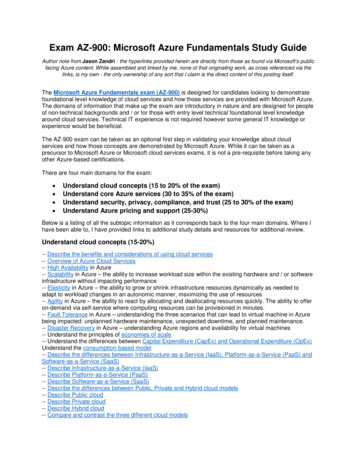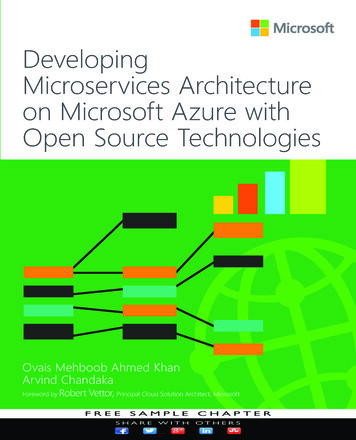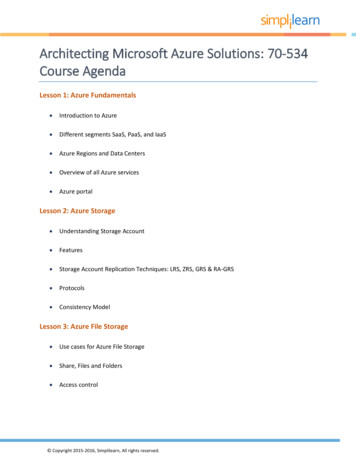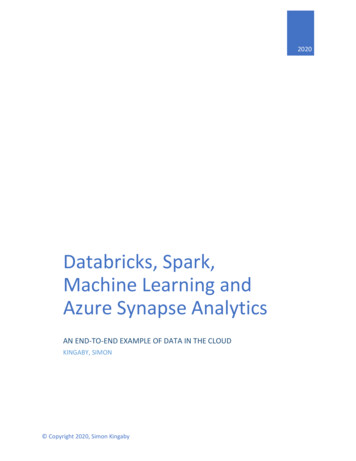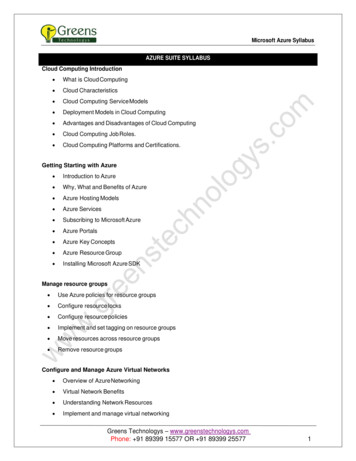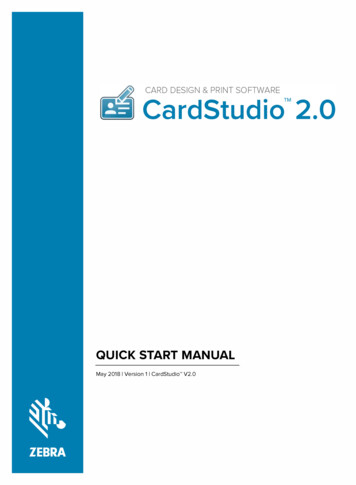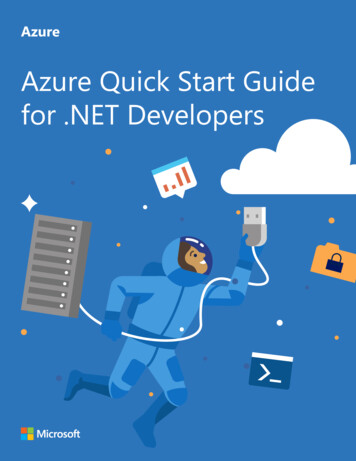
Transcription
AzureAzure Quick Start Guidefor .NET Developers
Contents4Azure for .NET developers4What can Azure do for you?7Getting Started with Azure services7Running your .NET applications in Azure7Azure App Services8There are several different types of App Service apps.9Azure Functions10Azure Logic Apps11Azure Virtual Machines12A word about microservices and containers13Which frameworks and technologies can you use in which Azure service?14Storing your data in Azure15Azure SQL Database16Azure Cosmos DB17Azure Storage18Let’s explore the different types of Azure Storage:19Azure Databases for MySQL, PostgreSQL, and MariaDB20Azure SQL Data Warehouse and Azure Data Lake Store2
21Securing your .NET applications in Azure21Azure Active Directory22Azure Key Vault22Managed Service Identity23Azure Advisor23Other Azure services23Enhance your application with performance23Machine Learning24Internet of Things (IoT)24Data Analytics25Messaging25Media Services25Monitoring27Tools for developing, debugging and troubleshooting27Visual Studio and Azure28Cloud Explorer29Publish to Azure31Snapshot Debugger32Azure Storage Explorer33Azure Storage Emulator3
33Azure Command-Line Interface35Azure Functions Core Tools35Cosmos DB Emulator36Azure DevOps for build and deployment39Summary and how to get started for free39Keep learning with an Azure free account40About the team4
Azure for .NET developersIf you are a .NET developer or architect who wants to get started with Microsoft Azure,this book is for you! Written by developers for developers in the .NET ecosystem, thisguide will show you how to get started with Azure and which services you can use to runyour .NET applications and store your data in a more efficient and secure way.Before we dive in, let’s take a moment to see what the cloud, and Microsoft Azure inparticular, can do for you.What can Azure do for you?Azure provides services that can help you accomplish many things. These range fromthe mundane—such as adding search functionality to your application or spinning upa new SQL database to connect to your recent .NET app—to more exotic projectssuch as implementing continuous integration (CI) and continuous deployment (CD)workflows. You also can automatically tune your database or set up push notificationsto mobile devices, easily and quickly. These are just a few examples of some commonprojects that developers have repeatedly had to create for themselves but that arenow available as a service. And you can use these services with little effort—almostlike flipping a light switch! You can then focus on the pieces of your application thatmake it unique—the features that provide real added value for your users.Besides services, Azure offers compute resources in the form of virtual machines (VMs),containers, databases, web app services, and mobile services. You can use these to hostapplications or to provide a complete infrastructure for your users, most of which youcan do through Visual Studio.The power of the cloud is that services and resources are incredibly robust and resilient.It is very unlikely that they will fail to run, because the cloud is smart and self-healing.With Azure, there are datacenters all over the world, filled with tens of thousands ofservers. If one server fails, another takes over. If an entire datacenter were to fail (a highlyunlikely scenario), another would take over. All this is possible because of the massivescale of the cloud.Azure Quick Start Guide for .NET Developers5
One of the most compelling arguments in favor of the cloud is that you can scale upyour services and resources almost infinitely, with just a few clicks of a button. You can’tdo that with on-premises resources unless you’re prepared to spend enormous sums ofmoney on capital equipment which would remain largely idle and staff to administer itall. You can scale globally without having to build data centers around the world byputting your services anywhere in the world eliminating latency and providing a highperformance experience to your users, regardless of where they are. It also means thatyou can keep your data where you need it to be, observing data residencyrequirements.Equally important, when you use cloud resources, you can scale back your services andresources when there is no longer high demand. This allows you to scale up and downeven during the course of a normal day keeping applications economical andperformant.In addition to massive scalability, off-the-shelf intelligent services, and pay-per-useefficiency, the cloud offers increased security. The cloud is used by millions of people,24x7, worldwide. Of course, it is also attacked by many people. Reputable andexperienced cloud providers like Microsoft recognize the usage patterns of normal usersand those of malicious actors. This means we know how to protect against both themost common and most unique attacks out there. Intelligent monitoring tools, machinelearning algorithms, and artificial intelligence give cloud providers the ability to detectattacks in real time and stop them in their tracks.Decades of experience in security and massive-scale traffic, combined with top industrysecurity expertise, make the cloud a much more secure environment than any onpremises datacenter.More infoTo read more about how Azure secures your applications and data, read the official AzureSecurity blog, Azure Security Overview, and how to get started with Azure Security.We’ve briefly explored reasons to begin your migration to the cloud and Microsoft Azure.Now, let’s examine which Azure services are useful for you for running and securing yourapplications and storing your data.Azure Quick Start Guide for .NET Developers6
Getting Started with Azure servicesLet’s explore some of the services that you can use for running your applications inAzure, storing your data in Azure, and securing your application with Azure.Running your .NET applications in AzureOne of the first decisions that you need to make when you start with Azure is whichservice(s) to use to run your applications in Azure. There are many options. Let’s start bylaying out which Azure services are most suitable for which application types in Table 1.Table 1: Which Azure services are best suited for which types of applications?App ServiceWeb AppsApp ServiceMobileAppsAzureFunctionsMonolithicand N-TierapplicationsMobile appback endLogic AppsAzureKubernetesService cearchitecturebasedapplicationsBusiness processorchestrationsand workflows* For lifting and shifting existing applications to Azure.Azure App ServicesOne of the easiest and most powerful ways to host your applications in Azure is in AzureApp Service. Azure App Service is a group of services that takes care of hosting yourapplication and abstracting away the complexities of the operating system andinfrastructure. They are highly available by default and will stay up and running for atleast 99.95% of the time.Azure Quick Start Guide for .NET Developers7
They share powerful features like automatic scaling, zero-downtime deployments, andeasy authentication and authorization. They also allow you to debug your applicationwhile it is running in production (with the Snapshot Debugger) and work very well withApplication Insights, which you can use to monitor every aspect of your app, fromperformance to usage.There are several different types of App Service apps.Azure Web AppsRunning a .NET web application in Azure is very easy in Azure Web Apps. Web Apps actas a web server as a service, like IIS. And you can simply deploy your ASP.NET orASP.NET Core application with Visual Studio to Web Apps and run it. These can bewebsites, APIs, or any other HTTP-driven application including Node.js, Python and Javaapplications.Once your application runs in an App Service web app, you can scale it up or down, addeasy authentication, use deployment slots, enable continuous deployment, and use anyof the other App Service features. By default, your application is available on theinternet, without you needing to set up a domain name or configure DNS settings,although you can do that.Try it now - Get started by creating an ASP.NET Core web app in AzureContainers on App ServicesDevelopers who want the power of App Services but need to maintain a higher level ofcontrol over their environments can also run containers. Both Linux and Windowscontainers are supported. You can deploy your own containers from the AzureContainer Registry, a private Docker registry or public containers from the Docker Hub.This allows you to run a wide range of pre-configured applications from WordPress toRedis which can be deployed either as single containers or as part of a multi-containerapplication. Windows container support also helps you migrate existing ASP.NET appsand WCF services that need access to the Windows OS, install custom components, oruse the Global Assembly Cache (GAC).Azure Quick Start Guide for .NET Developers8
Azure Mobile AppsIf you are building mobile applications, you will need a back end that the mobile appconnects to. Usually, this is some sort of API that your app can use to retrieve and storedata. Azure Mobile Apps provides you with such a back end. You can write it in C# oruse any of the Quickstart applications.A mobile back end that runs in Azure Mobile Apps provides unique capabilities. Forinstance, you can use offline sync, which enables the mobile app to continue workingwhen there is no connection to the back end and sync changes once the connection isrestored. And with push notifications you can send notifications to the mobile appsusing C# code, regardless of the platform it runs on (iOS, Android, Windows). In additionto these unique features, Mobile Apps shares all the other features of Azure App Service.Get started by creating an Android app with an Azure mobile app back end.Azure Functions (also known as serverless compute)Azure Function apps enable you to create Azure Functions in C# and many otherlanguages in Visual Studio and other IDEs and editors. Each Functions app contains oneor more Azure Functions and provides integration with authentication and deploymentslots.The Azure Functions that run in Azure Function apps are small pieces of code that youwrite, without you having to worry about the underlying infrastructure or about scaling.Many refer to this deployment model as Functions as a Service (FaaS).Function applications can be simply triggered by a wide variety of events originatingboth inside and outside of Azure. HTTP triggers allow web requests to be served by afunction app. Event Grid events can trigger Azure Functions when changes are made toAzure resources such as the container registry and virtual machines.Azure Quick Start Guide for .NET Developers9
Here is an example: You write an Azure Functions app that executes every time a newimage file is uploaded to Azure Storage. You then take that image, rename it, andoutput it to another Azure Storage account.This is very easy to do. You just write the code to rename the image. Azure Functionstakes care of getting the input image when the function is triggered. And it takes care ofwriting the image to the other storage account. It takes care of all the plumbing, andyou just write the code.Azure Functions even handles scaling for you. So it doesn’t matter if there are 1,000images that trigger the function at the same time. Azure Functions transparently spins upmore functions to deal with it and they go away when the code is done executing.Because of this, you only pay for the code that you execute, not for a service that runs allthe time, waiting to be triggered.Azure Functions are great for executing small pieces of code that perform one or twosteps on an input and an output. If you want to perform more steps of a larger process,you can use Durable Functions.Durable Functions provide a stateful experience on top of a series of Azure Functions.They enable complex patterns such as scatter/gather and function chaining. A DurableFunction orchestration may be as simple as coupling together two functions, one afteranother, or as complex as coordinating tens of thousands of function calls over weeks.Get started by creating your first Azure Function with Visual Studio.Azure Logic AppsDurable Functions are a fantastic orchestration tool for developers who are comfortablewith writing every step of the process inside a series of Functions. For those looking fora lower code solution Logic Applications may be better. With Azure Logic Apps, you canorchestrate a process just by weaving API calls together in a visual designer in VisualStudio or the Azure portal. Visual Studio offers a specific Logic Apps project template toget started.Azure Quick Start Guide for .NET Developers10
A logic app has a trigger, just like an Azure function does. This can be an outside trigger,like when a new blob is added, or a certain text is tweeted. Or it can be a manual triggeror a trigger on a schedule such as every 15 minutes.Once triggered, a logic app takes its input and calls APIs with it to complete a process.You just click this together by choosing APIs from a large list of available ones andchoosing the input and output for those APIs. Azure Functions can also be used for APIsin a logic app. And you can use your own ASP.NET Core APIs.Here’s an example:A logic app gets triggered by a new blob that is written in Azure Blob storage . It takes theBlob input, which is an image file, and resizes the image by calling an Azure function thatdoes just that. Next, it takes the resized image and writes it to another storage account.And finally, it calls the Office 365 API to send an email to the administrator that there is anew, resized image available.Just like Azure functions, logic apps scale automatically, you just create the process. It will trigger asmany times as it is needed and always executes the complete process and has reliability features, likeretry policies, built in. And because it only runs when it is triggered, you only pay for when it runs—youdon’t pay for owning it.Get started by building your first logic app workflow in the Azure porta l.Note: Azure Logic Apps and Azure Functions work very well with the Azure Event Grid service. Event Grid allows you tosubscribe to events, like when something happens in your application, and to push that information as an event that cantrigger a Logic App or an Azure Function.Azure Virtual MachinesA very different way of running your application is by taking advantage of Azure VirtualMachines. This is an easy way to get started, because you can lift-and-shift existingapplications from virtual machines that you run in your datacenter to VMs that run inAzure. There are many predefined VM images that you can use, like Windows Server2019 that runs IIS and has ASP.NET installed and preconfigured on it. You can evenbring your own software licenses if you already have one (like for SQL Server).Azure Quick Start Guide for .NET Developers11
Running your application in a VM doesn’t provide you the features like zero-downtimedeployments and easy authentication. You are also responsible for patching theoperating system and for making sure that antivirus software is up to date.On the other hand, it does provide you with the ability to easily scale your VM to abigger size or automatically scale it down when it isn’t used that much. Virtual MachineScale Sets allow for scaling out VMs to a large number of nodes and load balancingwork between them. And it offers you the reliability of running something in Azure. It isvery unlikely that your VM will stop running, and Microsoft guarantees this uptime witha comprehensive SLA.And if you’re not ready to run your production VMs in Azure you can still takeadvantage of streamlined DevOps and testing with Azure DevTest Labs.Get started by Creating a Windows virtual machine with the Azure portal.A word about microservices and containersYou can run your applications in containers, which are very lightweight and start andstop in seconds. Containers isolate your application and its dependencies in a way thatguarantees that you’ll never run into library version conflicts. They can be based onnumerous popular Linux distributions or Windows Server so no matter the platform yourapplication uses it can run in a container.A popular approach for containers is to use them to run a microservices architecture.This means that you create many small, isolated, services that each have their ownfunction and each have separate development and deployment lifecycles. Containerscan also be used to lift and shift existing applications to run at scale in the cloud.Azure provides several services to support running a microservices architecture incontainers. Running the increasingly popular orchestration engine Kubernetes, AzureKubernetes Service (AKS) provides a powerful tool to run anything from a handful ofcontainers to hundreds of thousands of them. AKS can all run and orchestratecontainers. Orchestration of containers is quite different from orchestrating a process,like Logic Apps does. Orchestrating containers means that you manage their lifecycles.Provision new ones, scale up or down, manage failures, and so on.Azure Quick Start Guide for .NET Developers12
You can learn more about microservices by reading:.NET Microservices Architecture GuidanceWhich frameworks and technologies can you use in which Azure service?Now that you know what the options are for running your application in Azure, it isextremely useful to know which version of .NET you can run in these services and whatkind of containers they support. Table 2 explains this by showing which framework andcontainer types you can use in which services in Azure.Table 2: Which framework and technology can you use in which Azure serviceWeb AppsMobileAppsFunctionsAzure S).NET Frameworkapps.NET Core appsLinux ContainersWindows ServerContainersAzure Quick Start Guide for .NET Developers13
Storing your data in AzureData is a particularly important aspect of any modern .NET application, and it comes inall shapes and sizes. Azure provides many types of data stores that can help youmaintain and retrieve data in any scenario.Table 3 shows which data service to use for which scenario.DatabaseCosmos DBBlobTableFilePostgreSQL,MySQLSQL DataWarehouseData LakeStoreRelational dataUnstructureddataSemistructureddataFiles on diskStore large dataStore smalldataGeographicdatareplicationTunable dataconsistencyAzure Quick Start Guide for .NET Developers14
Azure SQL DatabaseIf you are familiar with .NET, you will likely be familiar with SQL Server. In Azure, you canrun your SQL Server workload in Azure SQL Database. This is SQL Server in the cloud. Itis the same thing that you run on-premises but it offers a lot of advantages.You can do (almost) everything with it that you can do with on-premises SQL Server.And, in fact, new SQL Server features are incorporated in Azure SQL Database first andlater in the on-premises SQL Server.You can use Azure SQL Databases with your favorite tools, like Azure Data Studio, ServerExplorer and SQL Server Data Tools in Visual Studio and SQL Server ManagementStudio.Because they run in the cloud, Azure SQL Databases are fully managed, scalable, andhigh performing. They are automatically backed up and have many advanced features,such as: Single-click Geo-replication, which replicates data to other geographical regions inreal time, incredibly easily. (Get started with geo-replication.) Dynamic data masking, which masks sensitive data for certain users at runtime.(Get started with dynamic data masking.) Auditing, which provides a complete audit trail of all the actions that happen to thedata. (Get started with Azure SQL Database auditing.) Automatic database tuning, which monitors the performance of your database andtunes it automatically. (Get started with Azure SQL Database automatic tuning.)Azure Quick Start Guide for .NET Developers15
In addition to all these features, Azure SQL Databases are exceptionally reliable bydefault. Without configuring anything, transaction log backups are made every 5-10minutes and differential backups every 12 hours. These backups are stored three timesin the local datacenter and three times in another datacenter. And you can restorebackups from 35 days ago, depending on the pricing tier that you use.It is very easy to use Azure SQL Databases from a .NET application. You can, for instance,use the Entity Framework (or Entity Framework Core) to access the database and writeand read data to and from it. For the most part accessing data programmatically is nodifferent from accessing data in an on-premises SQL Server.Get started by creating an Azure SQL Database in the Azure Portal.Azure Cosmos DBAzure Cosmos DB is a new kind of database that is globally distributed and cloud native.Here are some of its key features: A 99.99% SLA (99.999% for read operations) that includes low latencies (less than 10ms on reads; less than 15 ms on writes). Geo-replication, which replicates data to other geographical regions in real time(How to distribute data globally with Azure Cosmos DB). Tunable data consistency levels, so you can choose data consistency, enabling atruly globally distributed data system. You can, for instance, choose strongconsistency, eventual consistency, or session consistency. Traffic management, which sends users to the data replica to which they are closest. Limitless global scale. You pay only for the throughput and storage that you need. Automatic indexing of data. No need to maintain or tune the database anymore.In addition to all these features, Cosmos DB offers different APIs with which you canstore and retrieve data, including SQL, Gremlin, MongoDB, Azure Table Storage, andApache Cassandra. Different APIs handle data in different ways. You can use documentsas data as well as unstructured tables, graphs, and blobs. You use the API that fits yourAzure Quick Start Guide for .NET Developers16
needs, and Cosmos DB takes care of the rest. If your application already uses one ofthese protocols switching to Cosmos DB is as simple as changing a connection string.You benefit from cloud-grade performance, scalability, and reliability, and still use theprogramming model to which you’re accustomed.You can use Cosmos DB from .NET Framework and .NET Core. For example, you can useits SQL API through the NuGet package Microsoft.Azure.DocumentDB orMicrosoft.Azure.DocumentDB.Core (for .NET Core).Get started with Azure Cosmos DB with the SQL API and .NET Core.Azure StorageWith Azure Storage, one of the most fundamental services in Azure, you can store datain different forms. It is easy to use, fast, and inexpensive. Azure Storage offers severaltypes of storage that you can use for different scenarios. All these storage types sharecommon features like encryption for data at rest, security through shared accesssignatures, and firewalls and virtual networks.Azure Storage is also very reliable. By default, data is replicated three times within thedatacenter. You can also choose geo-replicated storage, which, in addition to the threelocal replicas, replicates the data three times to another datacenter. You can create yourapplication in such a manner that it reads from this geo-replicated data, which is closeto your users, so that it is geographically high performing.You can use Azure Storage from your .NET Framework and .NET Core applications byusing the WindowsAzure.Storage NuGet package and referencing the specific API thatyou need, like Microsoft.WindowsAzure.Storage.Blob (for Blob storage) in a usingstatement in your code.Azure Quick Start Guide for .NET Developers17
Let’s explore the different types of Azure Storage:File StorageAzure File storage uses the SMB protocol, which makes it very suitable for lifting andshifting your file server into the cloud. When you have files in Azure Files, you can mountan Azure file share to a VM or even to your own Windows machine, to use as externalstorage.Get started with Azure Files.Azure Disk Storage is a similar service to Azure File but is dedicated to a single machine.It is available in four different performance levels from Standard HDD to Ultra SSD. Thehigh performance tiers are suitable for heavy I/O workloads such as running SAP HANAor complex analytical models.Table StorageAzure Table storage is an inexpensive and extremely fast NoSQL key-value store thatyou can use to store data in flexible tables. A table can contain one row describing anorder and another row describing customer information. You don’t need to define adata schema. This makes Table Storage very flexible.Get started with Azure Table storage.Blob StorageYou can use Azure Blob storage to store large unstructured data—literally, blobs of data.This can be video, image, audio, text, or even virtual hard drive (VHD) files for VMs.Additionally, you can use Blob tiers to reduce your storage costs. By default, blobs arewritten to the hot tier, which means that they are written and read very fast. You canalso put blobs in the cool tier if you have data that is infrequently accessed and storedfor at least 30 days. The cool tier is less expensive than the hot tier. And finally, you canstore blobs in the archive tier, that is the least expensive. The archive tier is for dataAzure Quick Start Guide for .NET Developers18
that is rarely accessed and stored for at least 180 days. Reading data from the archivetier can take hours. Blob tiering is a great way to save costs if you are storing largeamounts of data.Get started with Azure Blob storage.Queue StorageAzure Queue storage is an unusual type of storage in that it is used to store smallmessages of data, but its main purpose is to serve as a queue. You put messages on thequeue and other processes pick it up. This pattern decouples the message sender fromthe message processor and results in performance and reliability benefits. Azure Queuestorage is similar to Microsoft Message Queuing that you can find in Windows.Get started with Azure Queue storage. Note: Azure Service Bus Topics and Queues also provide queuing mechanisms, with slightly different properties than Azure Storagequeues.Azure Databases for MySQL, PostgreSQL, and MariaDBAs a .NET developer, you encounter many different open-source database types in yourjob. Some of them can now be used in a managed version in Azure.Azure provides MySQL, PostgreSQL, and MariaDB databases as managed databases,which means that you just spin them up and don’t have to worry about any of theunderlying infrastructure. Just like Azure SQL Databases and Cosmos DB, thesedatabases are universally available, scalable, highly secure, and fully managed.Each of these is suited for slightly different use cases, but in general, their functionalityoverlaps a lot. You would use Azure Databases for MySQL, PostgreSQL, and MariaDBwhen you are already using one of their on-premises versions and want the advantageof having that run fully managed in the cloud. Migrating apps that use these databasesis much easier when the data can remain in its original platform. Azure also provides anout of the box backend for services like WordPress which rely on open source databases.Azure Quick Start Guide for .NET Developers19
Get started with Azure Database for MySQL by creating a MySQL serverby using the Azure portal.Azure SQL Data Warehouse and Azure Data Lake StoreSince we are talking about storing data in Azure, we can’t leave out the data stores forbig data and data analytics. These are not typical stores that you use with yourapplication, but rather stores that you use for data analytics and reporting.Azure provides two data stores that are very suitable for storing large amounts of datafor data analytics purposes: the Azure SQL Data Warehouse and the Azure Data LakeStore.Each of these can hold petabytes of data. In fact, Azure Data Lake Store doesn’t evenhave limits on the amount of data and the file sizes that you can store.You use Azure SQL Data Warehouse when you know the questions that you want toanswer with data analytics. You define a data schema that determines what your datawill look like and how it can be used.You use Azure Data Lake Store when you don’t know the questions that you want toanswer yet. You do not have to define a data schema for the Data Lake Store. You storedata in its native format.You can work with each of these data stores with tools in Visual Studio. And you can useany SQL tool, like SQL Server Management Studio, to work with Azure SQL DataWarehouse. You can even create eye-popping business intelligence dashboards andreports as a non-developer in Power BI.Additionally, you can use the Azure Management SDK for .NET to perform managementoperations on these services. You can, for instance, create a new Data Lake Storeaccount.Get started with Azure SQL Data Warehouse by creating and querya warehouse in the Azure portal.Azure Quick Start Guide for .NET Developers20
Get started with Azure Data Lake Store using the Azure portal.Securing your .NET applications in AzureBesides running your application and storing data, you need to secure it. Azure can helpyou with that by providing authentication and authorization through Azure ActiveDirectory and by helping you to keep secrets safe with Azure Key Vault and insertingcredentials into your application with Managed Service Identity. Let’s examine theseservices.Azure Active DirectoryAn important part of your application’s security is authenticating users before they canuse it. Authentication is not an easy thing to implement. You need to store useridentities and credentials, implement password management, create a secureauthentication handshake, and so on.Azure Active Directory provides all these things and more out of the box. You store youruser identities in Azure Active Direc
3 21 Securing your .NET applications in Azure 21 Azure Active Directory 22 Azure Key Vault 22 Managed Service Identity 23 Azure Advisor 23 Other Azure services 23 Enhance your application with performance 23 Machine Learning 24 Internet of Things (IoT) 24 Data Analytics 25 Messaging 25 Media Services 25 Monitoring 27 Tools for developing, debugging and troubleshooting
